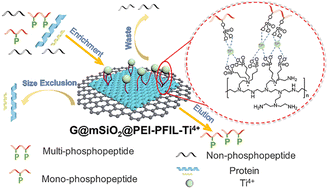Superhydrophilic nanocomposite adsorbents modified via nitrogen-rich phosphonate-functionalized ionic liquid linkers: enhanced phosphopeptide enrichment and phosphoproteome analysis of tau phosphorylation in the hippocampal lysate of Alzheimer's transgenic mice†
Abstract
In this study, new graphene-based IMAC nanocomposites for phosphopeptide enrichment were prepared according to the guideline of our new design strategy. Superhydrophilic polyethyleneimine (PEI) was introduced, to which a phosphonate-functionalized ionic liquid (PFIL) was covalently bound, to form superhydrophilic and cationic surface layers with high densities of nitrogen atoms, phosphonate functional groups, and high-loading metal ions. Due to the combined features of superhydrophilicity, flexibility, highly dense metal binding sites, large surface area and excellent size-exclusion effect, the fabricated nanocomposite G@mSiO2@PEI-PFIL-Ti4+ exhibits superior detection sensitivity to enrich phosphopeptides (tryptic β-casein digest, 0.1 fmol), and extraordinary enrichment specificity to enrich phosphopeptides from a digest mixture of β-casein and bovine serum albumin (BSA) (molar ratio, 1 : 12 000). The excellent size-exclusion effect was also observed, and 27 endogenous phosphopeptides were identified in human saliva. All these results could be attributed to the unique superhydrophilic nanocomposite structure with a high density of a cationic linker modified with phosphonate functionality. Moreover, G@mSiO2@PEI-PFIL-Ti4+ adsorbents were used to extract phosphopeptides from the tryptic digests of hippocampal lysates for quantitative phosphoproteome analysis. The preliminary results indicate that 1649 phosphoproteins, 3286 phosphopeptides and 4075 phosphorylation sites were identified. A total of 13 Alzheimer's disease (AD)-related phosphopeptides within tau proteins were detected with a wide coverage from p-Thr111 to p-Ser404, in which the amounts of some phoshopeptides at certain sites in AD transgenic mice were found statistically higher than those in wild type littermates. Besides, phosphorylated neurofilament heavy chains, a potential biomarker for amyotrophic lateral sclerosis and traumatic brain injury, were also identified. Finally, the adsorbent was applied to human cerebrospinal fluid (CSF) and blood samples. 5 unique phosphopeptides of neuroendocrine specific VGF were identified in the CSF, while many phosphopeptides originated from the nervous system were found in the blood sample. All these results suggest that our new IMAC materials exhibit unbiased enrichment ability with superior detection sensitivity and specificity, allowing the global phosphoproteome analysis of complicated biological samples more convincible and indicating the potential use in disease diagnosis.

- This article is part of the themed collection: Journal of Materials Chemistry B HOT Papers


 Please wait while we load your content...
Please wait while we load your content...